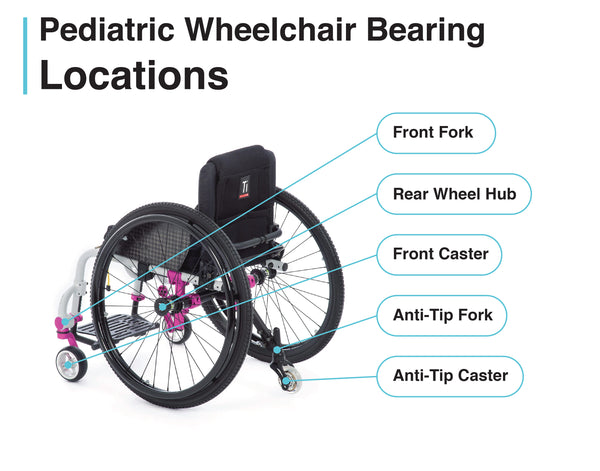In this article we will cover:
- What bearings are found on an adult and pediatric manual wheelchairs
- How often you should service or replace your bearings
- What are the components in a wheelchair bearings
- What considerations and features you would look for in your replacement bearings
What Bearings are found on Adult Manual Wheelchairs:

Adult manual wheelchairs have three component that uses bearings. They are:
- Rear Wheel Hub
- Front Fork
- Front Caster
Each component uses 2 bearings and there are two of each component on the wheelchair a right and left-hand component. That means there are 4 bearings each for the rear wheel hubs, the forks, and the casters.
Tip: When buying new bearings make sure you buy the right number. If you are replacing all the bearings on your wheelchair then you need to buy 4 caster bearings, for front fork bearings and 4 rear wheel hub bearings.
What Bearings are found on Pediatric Manual Wheelchairs:

Pediatric wheelchairs have all of the same bearings as adult wheelchairs and in some cases, they have more. Some pediatric wheelchairs are equipt with a 5th type anti-tip device as shown in the picture above. Unlike adult anti-tip devices which do not normally use a bearing, a pediatric anti-tip will have a fork and a caster. Each competent will have 2 bearings.
Tip: When buying new bearings make sure you buy the right number. If you are replacing all the bearings on a pediatric wheelchair then you need to buy 6 caster bearings, 6 fork bearings, and 4 rear wheel hub bearings.
How often you should service or replace your bearings:
Most wheelchair manufacturers suggest that you service your wheelchair bearings at least once a year. Why? Great question and that answer is simple; Water is not your wheelchairs friend. It can seep into the bearings and causing them to rust. This, in turn, increases the amount of effort you need to push your wheelchair.
Service usually means cleaning any hair from around your casters or forks. It can mean regressing or lubricating your bearings. It also means that if your bearings are not rolling properly you replace them with new bearings.
Tip: You can service and re-grease your bearings. Some people try to use stray like WD-40 to do this. Don’t, WD-40 is a degreaser, which is exactly what you do not want. If you spray a little WD-40, it may stop the bearing from squeaking for a little while but it will break down the grease in the bearings. You should remove the bearing, remove the seals and add grease, repack and replace. Since you are going through all of that most people just put new bearings in instead.
What are the components in a wheelchair bearing:

Bearings are made up a few key components and depend on how they are used are made up of different materials. Wheelchair bearings are made of ball bearings held together in a cage between an out and inner ring. On each side, there are shields keeping debris and water from getting in. Using high-quality steels and plastics are very important but there is something else and that is using the right high-quality lubricants.
What considerations for wheelchair bearings:
The original equipment manufacture’s (OEM) bearings are not necessarily the best or longest lasting bearings out there. You will not go wrong using OEM bearings. Just know that there are better bearings out there.
Tip: You can get even better quality bearings then the OEM and in most cases, you will not spend more to do so.
Bearings should be round. Most bearing manufacturers will use ABEC scale for measuring roundness. It is a little counter-intuitive, ABEC 1 is less round then ABEC 3. The higher the number the more round the ball. The scale is ABEC 1, 3, 5, 7 and 9. I have seen some people advertise ABEC 11 but there is no literature to support it. Most OEMs use an ABEC 3 and some even use ABEC 1.
Tip: ABEC 3 or ABEC 5 bearings are fine, you don't need to go any higher unless you are a performance athlete.
Helpful Resources:
We have put together the bearing and bearing tools for the most common manual wheelchair found in the United States.
- TILite Bearings and Bearing Tools
- Quickie Bearings and Bearing Tools
- Ki Mobility Bearings and Bearing Tools
- Frog Legs Bearings and Bearing Tools
- Spinergy Bearings and Bearing Tools
If you have any questions please contact us, we would love to help